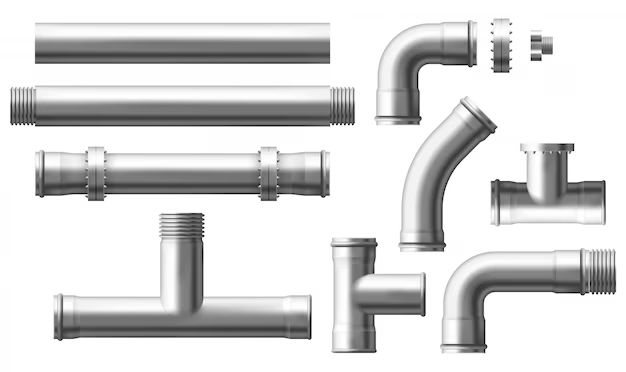Page Contents
Quick Answer
No, a PVC compression coupling will not work on galvanized pipe. PVC and galvanized pipe are incompatible materials that should not be used together in plumbing systems. The differences in their material properties and dimensions mean that a PVC compression coupling will likely not form a tight seal on galvanized pipe.
Can You Use a PVC Coupling on Galvanized Pipe?
PVC and galvanized pipe have very different material properties that make them incompatible for use together. Here are the key differences:
- PVC is a plastic material, while galvanized pipe is made from steel.
- PVC is not rigid like galvanized pipe – it expands and contracts with temperature changes.
- Galvanized pipe is threaded, while PVC uses solvent welds or compression fittings.
- The dimensions of PVC and galvanized pipe are different, especially the outside diameters.
These differences mean that a PVC compression coupling relies on a smooth, consistent outside diameter to create a tight friction fit when compressed. But galvanized pipe has threaded, rigid walls that are not smooth. The PVC coupling cannot compress adequately on the galvanized pipe’s threads and odd dimensions. This results in a very poor seal that is likely to leak.
Some key problems that arise when trying to join PVC and galvanized pipe with a compression coupling include:
- The PVC coupling cannot grip tightly onto the threads of the galvanized pipe.
- Galvanized pipe is larger in diameter, so the PVC coupling will be loose.
- The PVC and galvanized have different rates of thermal expansion, which stresses the connection.
- Over time, galvanized pipe corrodes and rusts, while PVC does not, further deteriorating the connection.
For these reasons, plumbing codes prohibit the use of PVC compression couplings on galvanized pipe. The mismatch in materials and dimensions means the connection is almost guaranteed to leak and fail over time.
Proper Connections Between PVC and Galvanized Pipe
While PVC and galvanized pipe should not be joined directly, there are proper fittings that can allow them to be used together in a plumbing system. The key is to use fittings that are specifically designed for joining dissimilar materials like PVC and galvanized pipe.
Some options include:
- PVC-to-Male Threaded Adaptors – These allow the PVC to connect to the male threaded end of galvanized pipe.
- Galvanized Threaded Nipples – A short section of galvanized pipe with male threads on both ends, used to extend galvanized pipe to connect to PVC.
- PVC Union Couplings – Designed specially to join PVC and male threaded pipe.
- Dielectric Unions or Galvanized Unions – Prevent galvanic corrosion between PVC and galvanized pipe.
These purpose-made fittings compensate for the differences between the pipes and create secure, leak-free connections. They have threaded ends to grip onto galvanized pipe and solvent-weld ends to connect to PVC.
Example of Connecting PVC and Galvanized Pipe
Here is an example of how to properly connect a PVC drain pipe to an existing galvanized drain line from a sink:
- Cut the galvanized drain pipe coming out of the wall above the connection point. This exposes fresh threads for connecting.
- Deburr the cut end of the galvanized pipe with a file to ensure smooth edges.
- Measure and cut the PVC drain pipe to the required length.
- Chamfer the end of the PVC pipe using sandpaper to ease insertion into the fitting.
- Apply primer and solvent cement to the end of the PVC pipe following the product instructions.
- Thread a galvanized threaded nipple into the prepared end of the galvanized drain pipe.
- Apply more primer & cement to the threads of the galvanized nipple.
- Thread a PVC female threaded adapter onto the galvanized nipple.
- Allow the cement to fully cure before pressure testing the connection.
This creates a secure threaded connection while keeping the dissimilar pipes separated. The galvanized nipple and the PVC adapter compensate for the differences between the pipe materials.
Can You Transition PVC to Galvanized Pipe with a SharkBite?
SharkBite push-fit connectors are sometimes used to quickly join different types of pipe. But SharkBite does not recommend using their push-fit couplings directly between PVC and galvanized pipe.
Like PVC compression couplings, SharkBite connectors rely on a smooth outside diameter of pipe to create a tight seal when pushed over the pipe. The rigid, threaded outside surface of galvanized pipe can damage the o-ring seal inside a SharkBite when you try to push it into place.
So SharkBite push-fit fittings are prone to leaking when used to directly transition between PVC and galvanized pipes. It’s better to use threaded transition fittings to connect the two different pipe materials.
However, SharkBite does make specialty fittings designed for joining PVC and galvanized pipe:
- SharkBite PVC-to-Copper/Galvanized Pipe Transition Union – Has both push-fit and threaded connections.
- SharkBite Galvanized Threaded Nipples – Can be used to extend galvanized pipe for connecting to PVC.
These SharkBite fittings have the same benefits of other threaded transition fittings and can safely join PVC to galvanized pipe. But a standard SharkBite push-fit coupling should not be used directly between PVC and galvanized pipes.
Conclusion
In summary, PVC and galvanized pipe cannot be joined successfully with a PVC compression coupling. The differences in their materials and dimensions means a PVC compression coupling will not properly seal on galvanized pipe.
Installing a PVC compression coupling directly onto galvanized pipe violates plumbing codes and will almost certainly leak. The only reliable way to transition between PVC to galvanized pipe is to use proper threaded transition fittings like PVC female adapters, galvanized nipples, or dielectric unions. This compensates for their differences and creates secure, leak-free connections.

